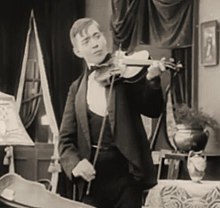Karl Brown (cinematographer)
Karl Brown | |
|---|---|
 Brown in the film Home, Sweet Home (1914) | |
| Born | December 26, 1896 McKeesport, Pennsylvania, U.S. |
| Died | March 25, 1990 (aged 93) |
| Occupations | |
| Years active | 1914–1960 |
| Spouse | |
Karl Brown (December 26, 1896 – March 25, 1990) was an American cinematographer, screenwriter, and film director. He was also a member of the American Society of Cinematographers and served as vice president from 1924 to 1925.
Career
Brown's first entertainment-related job, while still in his teens, was working at a development lab for the
The most successful film Brown worked on as cinematographer was the James Cruze film The Covered Wagon (1923). Brown's first directorial effort, Stark Love (1927), is today considered a rural cinematic masterpiece.
Brown was cinematographer on Wallace Reid's last film,
Personal life
Brown was the son of comedian and character actor William H. Brown. His mother, who styled herself Lucile Browne professionally, served as a chaperone and guardian to actresses at the Fine Arts Studio and made some film appearances.
He was married to Edna Mae Cooper from 1922 until her death in 1986.
Partial filmography
- Stage Struck (1917)
- Her Official Fathers (1917)
- Gasoline Gus (1921)
- Crazy to Marry (1921)
- Is Matrimony a Failure? (1922)
- The Dictator (1922)
- Thirty Days (1922)
- The Covered Wagon (1923)
- Hollywood (1923)
- To the Ladies (1923)
- Leap Year (1924)
- The Fighting Coward (1924)
- The Enemy Sex (1924)
- Merton of the Movies (1924)
- Welcome Home (1925)
- The Pony Express (1925)
- Beggar on Horseback (1925)
- Mannequin (1926)
- Stark Love (1927) (as director)
- The Mississippi Gambler (1929)
- Prince of Diamonds (1930)
- Flames (1932)
- In His Steps (1936)
- Federal Bullets (1937)
- Under the Big Top (1938) (as director)
- Numbered Woman (1938) (as director)
- The Man They Could Not Hang (1939) (screenplay)
References
- ^ Kevin Brownlow and Karl Brown (1991). "Hollywood in the Hills: The Making of "Stark Love"". Appalachian Journal. 18 (2): 170–220.
External links
- Karl Brown at IMDb
